
Design
Tania specialises in translating her textural photographs into timeless designs, interpreting the beauty of nature in to intricately hand knotted wool and silk rugs that will last for generations.
Most of Tania’s designs are very detailed and she personally creates every weaving graph herself thus ensuring each design is woven exactly as specified. This meticulous approach is reflected in every stage of the design process. Tania sends the final graph to the mill in Kathmandu where it is printed out and each colour position is then painted on by hand. Her use of close tonal colours along with the complexity of Tania’s designs makes them extremely difficult to weave. Every square on the weaving graph represents a knot that the weavers then produce by hand, knot by knot, requiring immense skill and patience.
In addition to our hand knotted rugs, we also offer handloom rugs. Our handloom collection comprises of a series of simple, gradated and geometric designs that are the perfect partner to our signature hand knotted collection.
Each Tania Johnson Design rug is made to order and can be produced in different knot counts, fibres and pile heights. We can create any size or shape and work to any brief, whether it is matching to a fabric, a piece of art or picking out poms with clients at their homes. As a starting point, we can quickly create a CAD render of any design in different colours to give our clients a visual idea and put together a yarn card before producing a small sample.
Lead time from order to delivery can take 3-9 months depending on the size, knot count and design complexity. And during production, we love to send our clients photos so they can see how their rug is developing
Most of Tania’s designs are very detailed and she personally creates every weaving graph herself thus ensuring each design is woven exactly as specified. This meticulous approach is reflected in every stage of the design process. Tania sends the final graph to the mill in Kathmandu where it is printed out and each colour position is then painted on by hand. Her use of close tonal colours along with the complexity of Tania’s designs makes them extremely difficult to weave. Every square on the weaving graph represents a knot that the weavers then produce by hand, knot by knot, requiring immense skill and patience.
In addition to our hand knotted rugs, we also offer handloom rugs. Our handloom collection comprises of a series of simple, gradated and geometric designs that are the perfect partner to our signature hand knotted collection.
Each Tania Johnson Design rug is made to order and can be produced in different knot counts, fibres and pile heights. We can create any size or shape and work to any brief, whether it is matching to a fabric, a piece of art or picking out poms with clients at their homes. As a starting point, we can quickly create a CAD render of any design in different colours to give our clients a visual idea and put together a yarn card before producing a small sample.
Lead time from order to delivery can take 3-9 months depending on the size, knot count and design complexity. And during production, we love to send our clients photos so they can see how their rug is developing
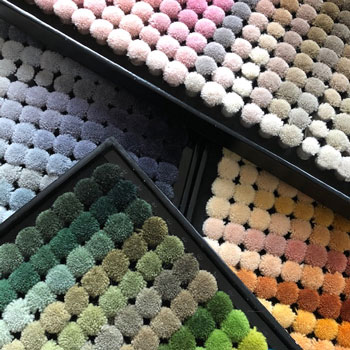

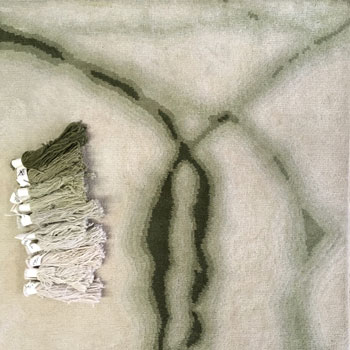
Manufacturing
All of our rugs are hand made in Nepal and producing them is a painstaking process. Tania works closely with her manufacturer, having worked with the same facility since starting her business, and visits Kathmandu regularly where she is constantly amazed by the incredible skill involved at every stage of production.
The raw Himalayan wool we use is first carded to break up and separate each fibre, making sure no fibre is mixed with another and removing any dirt. Once carded, the wool is ready to be spun. This is done by hand on a spinning wheel. Once the yarn has been spun, it needs to be dyed ready for weaving. Matching colours is a highly skilled and vital part of the hand knotting process, particularly as almost all of our rugs are custom coloured to work in very specific interiors. After dyeing, the yarns lie out in the sun to dry before being wound into balls.
The raw Himalayan wool we use is first carded to break up and separate each fibre, making sure no fibre is mixed with another and removing any dirt. Once carded, the wool is ready to be spun. This is done by hand on a spinning wheel. Once the yarn has been spun, it needs to be dyed ready for weaving. Matching colours is a highly skilled and vital part of the hand knotting process, particularly as almost all of our rugs are custom coloured to work in very specific interiors. After dyeing, the yarns lie out in the sun to dry before being wound into balls.
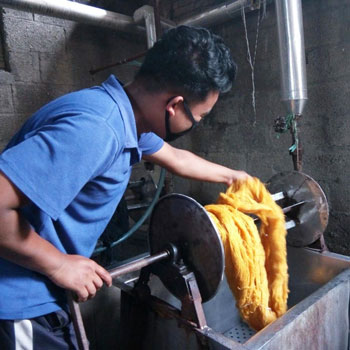
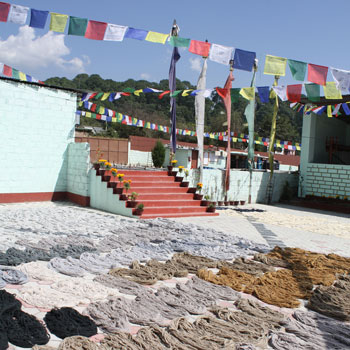
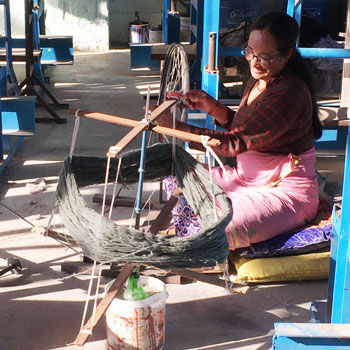
Once the yarns are dried and balled, the weaving process can begin. Preparing the looms for hand knotting can take several days. In some cases, for very large rugs, completely custom looms need to be built. The graph is then printed out and attached to the loom.
The size of the rug determines how many weavers need to work on it. For one of our larger rugs, for example, 11 weavers sat side by side weaving in unison. The skill and patience required, particularly for our intricate and challenging designs, is incredible.
The size of the rug determines how many weavers need to work on it. For one of our larger rugs, for example, 11 weavers sat side by side weaving in unison. The skill and patience required, particularly for our intricate and challenging designs, is incredible.


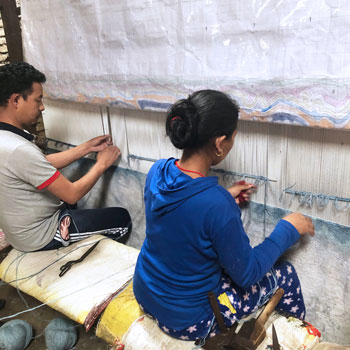
While our handloom rugs are quicker to weave than hand knot, it is still a time-consuming process requiring skill and experience. The yarns first need to be wound onto a number of spools ready for warping. Once the warp is complete, it is transferred to the hand loom and threaded for weaving. The rugs are then woven by shooting the shuttle through the loom while inserting rods that will determine the cut pile. Every few rows, the weavers stop to slice through the yarns between the rods, thus creating the pile before repeating the whole process.
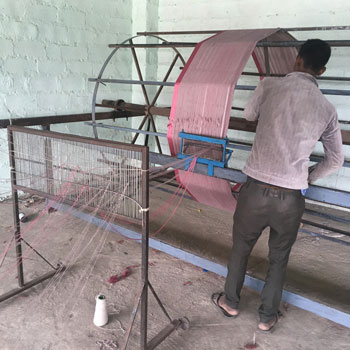
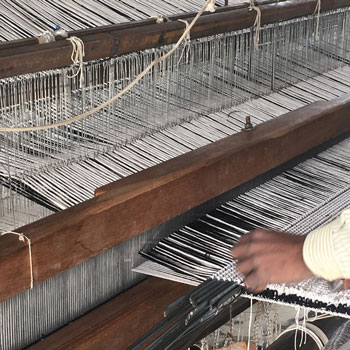

Once woven, the rugs are trimmed, washed by hand and laid out to dry in the sun. Depending on the time of year and how rainy it is, this process in itself can take days. Finally, once the rug has been stretched and is fully dry, the edges are neatly bound, given a final re-trimming and thoroughly inspected before being rolled and packed for shipping.



